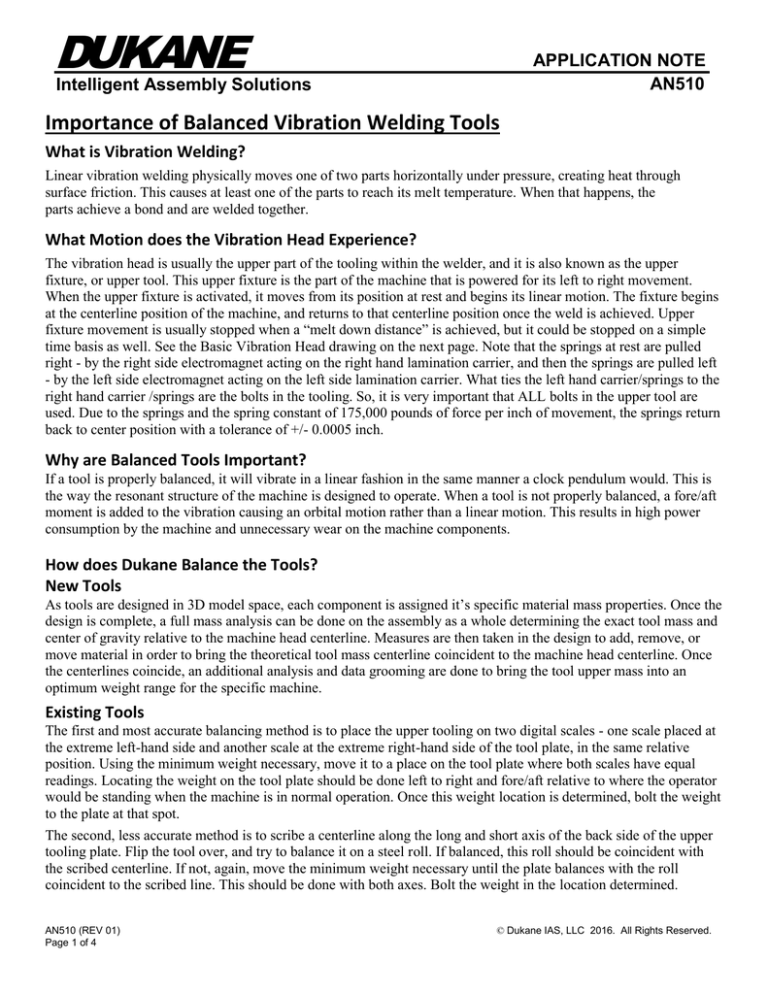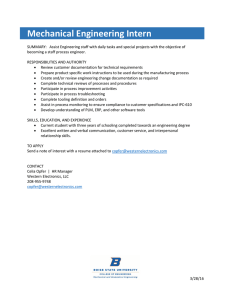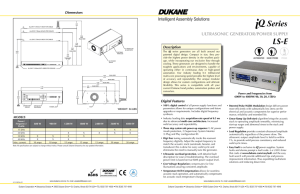
DUKANE
APPLICATION NOTE
AN510
Intelligent Assembly Solutions
Importance of Balanced Vibration Welding Tools
What is Vibration Welding?
Linear vibration welding physically moves one of two parts horizontally under pressure, creating heat through
surface friction. This causes at least one of the parts to reach its melt temperature. When that happens, the
parts achieve a bond and are welded together.
What Motion does the Vibration Head Experience?
The vibration head is usually the upper part of the tooling within the welder, and it is also known as the upper
fixture, or upper tool. This upper fixture is the part of the machine that is powered for its left to right movement.
When the upper fixture is activated, it moves from its position at rest and begins its linear motion. The fixture begins
at the centerline position of the machine, and returns to that centerline position once the weld is achieved. Upper
fixture movement is usually stopped when a “melt down distance” is achieved, but it could be stopped on a simple
time basis as well. See the Basic Vibration Head drawing on the next page. Note that the springs at rest are pulled
right - by the right side electromagnet acting on the right hand lamination carrier, and then the springs are pulled left
- by the left side electromagnet acting on the left side lamination carrier. What ties the left hand carrier/springs to the
right hand carrier /springs are the bolts in the tooling. So, it is very important that ALL bolts in the upper tool are
used. Due to the springs and the spring constant of 175,000 pounds of force per inch of movement, the springs return
back to center position with a tolerance of +/- 0.0005 inch.
Why are Balanced Tools Important?
If a tool is properly balanced, it will vibrate in a linear fashion in the same manner a clock pendulum would. This is
the way the resonant structure of the machine is designed to operate. When a tool is not properly balanced, a fore/aft
moment is added to the vibration causing an orbital motion rather than a linear motion. This results in high power
consumption by the machine and unnecessary wear on the machine components.
How does Dukane Balance the Tools?
New Tools
As tools are designed in 3D model space, each component is assigned it’s specific material mass properties. Once the
design is complete, a full mass analysis can be done on the assembly as a whole determining the exact tool mass and
center of gravity relative to the machine head centerline. Measures are then taken in the design to add, remove, or
move material in order to bring the theoretical tool mass centerline coincident to the machine head centerline. Once
the centerlines coincide, an additional analysis and data grooming are done to bring the tool upper mass into an
optimum weight range for the specific machine.
Existing Tools
The first and most accurate balancing method is to place the upper tooling on two digital scales - one scale placed at
the extreme left-hand side and another scale at the extreme right-hand side of the tool plate, in the same relative
position. Using the minimum weight necessary, move it to a place on the tool plate where both scales have equal
readings. Locating the weight on the tool plate should be done left to right and fore/aft relative to where the operator
would be standing when the machine is in normal operation. Once this weight location is determined, bolt the weight
to the plate at that spot.
The second, less accurate method is to scribe a centerline along the long and short axis of the back side of the upper
tooling plate. Flip the tool over, and try to balance it on a steel roll. If balanced, this roll should be coincident with
the scribed centerline. If not, again, move the minimum weight necessary until the plate balances with the roll
coincident to the scribed line. This should be done with both axes. Bolt the weight in the location determined.
AN510 (REV 01)
Page 1 of 4
© Dukane IAS, LLC 2016. All Rights Reserved.
DUKANE
Intelligent Assembly Solutions
APPLICATION NOTE
AN510
Specifications of Tool Balance
All tooling should be balanced as closely as possible to the theoretical machine head centerline without exceeding
the operating weight-range of the vibration welder for which the tooling is designed. Imbalance variations should not
exceed 3mm from the theoretical centerlines for both axes.
Handling Large, Complex Tools
LPT or large platform tooling means the fore/aft spring distance has been widened. This allows for larger parts to be
welded, and the tool itself can be larger as well. Bolting the tool to the head can be done in all areas of the upper
tooling due to an 80mm by 80mm bolt hole pattern on the upper tool plate which is mounted permanently in the
head. Standard machines have fewer bolt holes, and they are located in the springs which makes these machines less
adaptable for large part tooling to bolt into the machine.
Basic Vibration Head
AN510 (REV 01)
Page 2 of 4
© Dukane IAS, LLC 2016. All Rights Reserved.
DUKANE
Intelligent Assembly Solutions
APPLICATION NOTE
AN510
Dukane IAS, LLC
Intelligent Assembly Solutions
2900 Dukane Drive
St. Charles, IL 60174 USA
Tel: (630) 797-4900
Fax: (630) 797-4949
http://www.dukane.com/us
Disclaimer: Dukane IAS, LLC assumes no responsibility for any errors which may appear in this document, reserves the right to change devices or
specifications detailed herein at any time without notice, and does not make any commitment to update the information contained herein.
AN510 (REV 01)
Page 3 of 4
© Dukane IAS, LLC 2016. All Rights Reserved.
DUKANE
Intelligent Assembly Solutions
APPLICATION NOTE
AN510
DOCUMENT INFO:
DATE: 05/23/2016
ECN:
DRAWN: CCL
CHECKED: CCL
APPROVED: CCL
ENGINEER: CCL
REVISION INFO:
ISS
DESCRIPTION
APPD
DATE
01
Added document/revision page.
ECN 9825
DSS
07/12/2016
AN510 (REV 01)
Page 4 of 4
© Dukane IAS, LLC 2016. All Rights Reserved.






